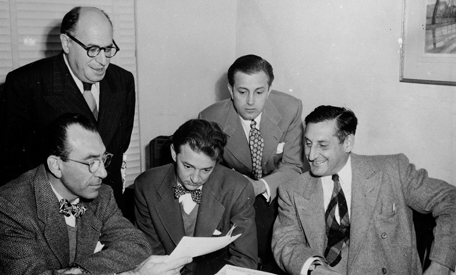
This is the second in a series of posts in which I discuss books on film noir that I have been reading, and which aficionados of film noir should find interesting.
In this post, I will look at CAUGHT IN THE CROSSFIRE: Adrian Scott and the Politics of Americanism in 1940s Hollywood (Columbia University Press, 2008) by academic historian Jennifer E. Langdon. The book can be purchased from Columbia University Press and the eBook is available free on-line at gutenberg.org
CAUGHT IN THE CROSSFIRE is ostensibly a biography of the activist writer and producer, Adiran Scott, who at RKO produced three seminal noirs of the 1940s directed by fellow progressive Edward Dmytryk: Murder, My Sweet (1944), Cornered (1945), and Crossfire (1947). Scott and Dmytryk were two of the HUAC Hollywood Ten. Historian Langdon devotes a number of chapters in the book on the production of Murder, My Sweet, Cornered, and Crossfire. The focus is on Crossfire and Scott’s adaptation with leftist writer John Paxton of the novel by Richard Brooks. Politics and the historical context aside, the chapters on Crossfire are a fascinating study of film production during the classic noir period. Andrew Feffer, Associate Professor, Director of American Studies, Union College New York, in a review of the book concluded that Langdon’s “detailed study of film production and politics is simply marvelous and well worth the read”.
What is most striking in Langdon’s lengthy account of the making of Crossfire is that it is a robust corrective to auteur theory. When film critics talk of Crossfire they see it as largely Dmytryk’s achievement. True, to the extent that he directed the picture we can give Dmytryk credit, but the screenplay is integral to the movie, and the very long and labored efforts of Scott and Paxton on that script must be acknowledged as deserving of equal if not greater recognition. Scott and Paxton were also closely involved in the shooting of the film, which was deliberately collaborative, as in the making of Murder, My Sweet and Cornered. Langdon relates an interest anecdote from the making of Murder, My Sweet (1944), as told by scenarist Paxton (my emphasis):
As a writer-friendly producer, Scott brought Paxton into the collaboration in ways that were not common within the highly segregated studio system. For example, he consistently invited Paxton onto the set, not only to have him on hand for possible rewrites, but simply to watch the filming. He also invited Paxton to watch the rushes and introduced him to the actors. Paxton recalled a minor stir when Scott introduced him to Dick Powell during the filming of Murder, My Sweet. “I will never forget the look of alarm and confusion on the face of the star when Adrian presented me as the Writer. He was a talented and friendly enough man, this actor, but I don’t believe he had ever met a writer before.” Paxton fondly recalled being invited along on trips to scout locations. “This was exhilarating, to be out with the fellows, crowded into the back seat of a stretch-out [limousine], suffocated by cigar smoke.” Paxton’s memories suggest a sort of boy’s-school camaraderie, and he clearly felt honored to be included in these masculine rituals, which were exalted by their intermingling of work and play. However, Scott dragged Paxton along to view rushes and scout locations not simply because he and Paxton were old friends and enjoyed spending time together. There was plenty of time to socialize outside of work, to play cards at each other’s homes or to have cocktails across the street at Lucey’s Restaurant, a popular gathering place for studio workers from RKO and Paramount. Scott included Paxton because he was trying to create a collaborative creative process, to break down the barriers enforced by the studio and to build a working unit. This creative—and political—agenda, this quest for a seamlessness between work and politics, reflected Scott’s larger political commitments and the spirit of the Popular Front. Paxton makes clear that Scott’s inclusion of him was unusual: “We [writers] had our place and we were expected to keep it. I might never have met a motion picture star if my friend, sponsor, and producer had not been Adrian Scott—a quite remarkable, and in his quiet way, a very radical man.”
Essential reading.

This is truly an extraordinary post that deserves attention in the noir community, especially among those who see the value of writing in the cinema. Dmytryk is a towering figure of course, and his artistic relationship with Adrian Scott is the fascinating essence of this (unquestionably) scholarly study for those who venerate these great works. Obviously, the central thrust here is the brilliant delineated bold print in the analytical assessment:
“Scott included Paxton because he was trying to create a collaborative creative process, to break down the barriers enforced by the studio and to build a working unit. This creative—and political—agenda, this quest for a seamlessness between work and politics, reflected Scott’s larger political commitments and the spirit of the Popular Front.”
Tremendous post.
LikeLike
Thanks Sam. Scott is an immensely interesting figure: a man driven by idealism with the ability to work inside the studio system with creativity and integrity.
LikeLike